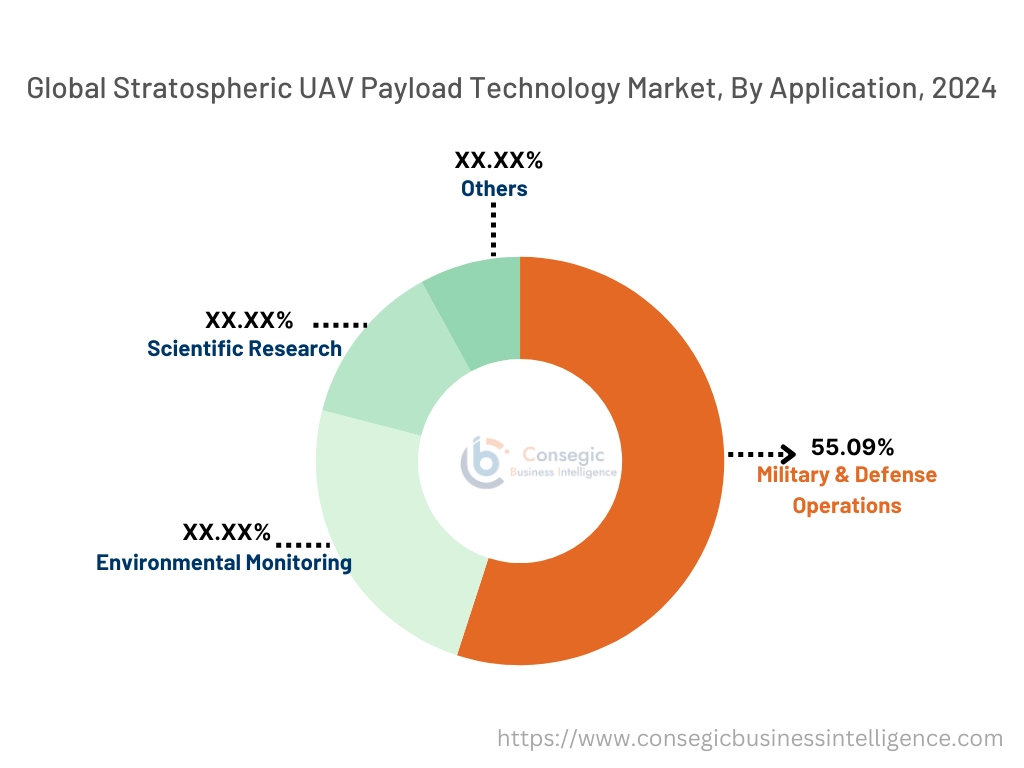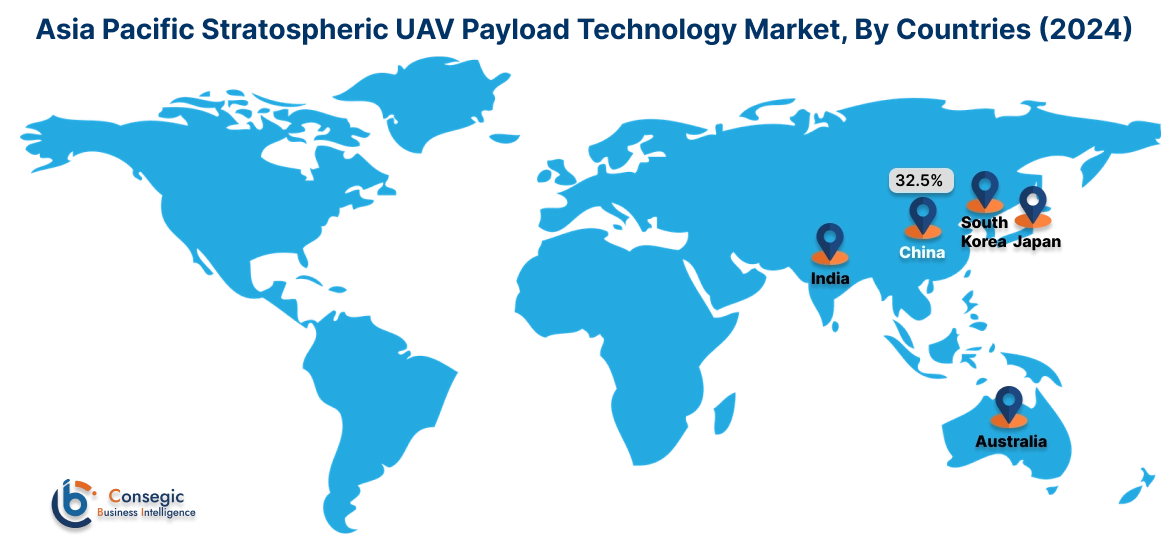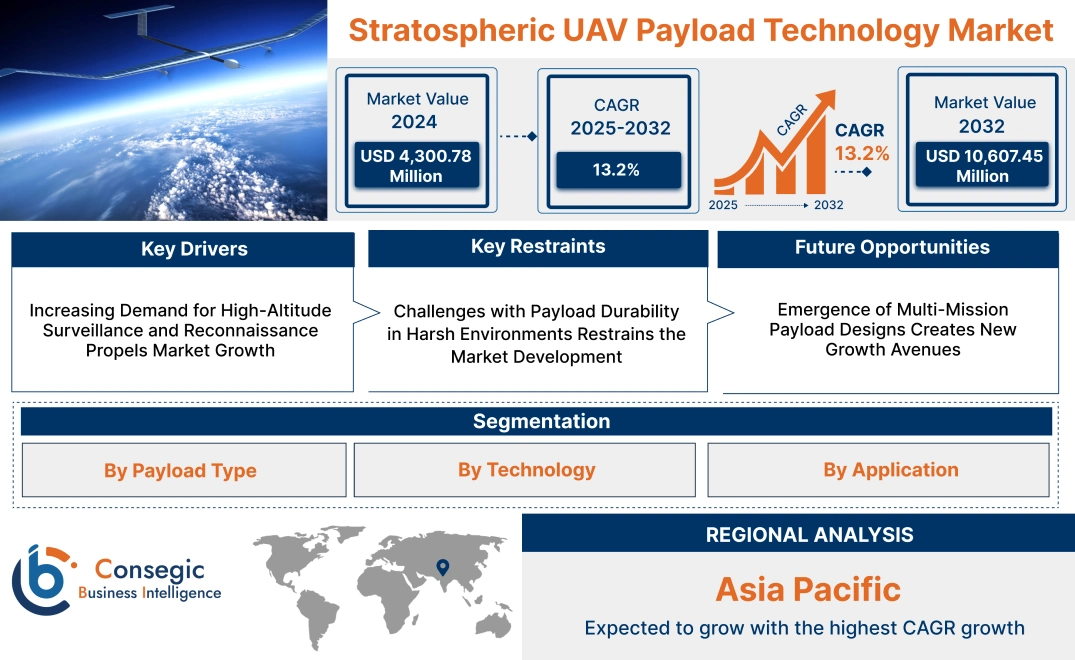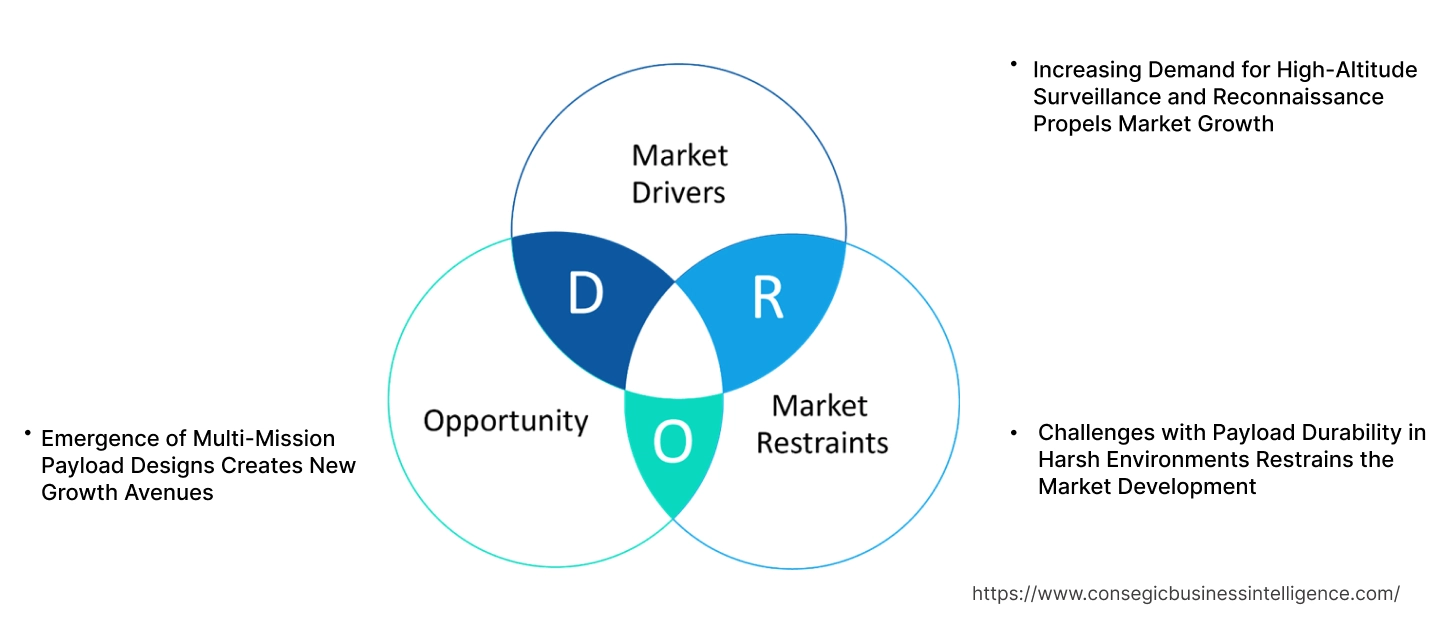- Summary
- Table Of Content
- Methodology
Stratospheric UAV Payload Technology Market Size:
Stratospheric UAV Payload Technology Market size is estimated to reach over USD 10,607.45 Million by 2032 from a value of USD 4,300.78 Million in 2024 and is projected to grow by USD 4,739.71 Million in 2025, growing at a CAGR of 13.2% from 2025 to 2032.
Stratospheric UAV Payload Technology Market Scope & Overview:
Stratospheric UAV payload technology encompasses advanced systems and components designed to equip unmanned aerial vehicles (UAVs) operating in the stratosphere. These payloads include sensors, cameras, communication devices, and scientific instruments tailored to perform tasks such as surveillance, data collection, and communication relay. Operating at high altitudes, these technologies enable UAVs to cover vast areas and provide enhanced capabilities compared to traditional platforms.
These payloads are engineered to withstand extreme atmospheric conditions, including low temperatures and reduced air pressure, ensuring reliable performance at stratospheric altitudes. They are integrated with lightweight and energy-efficient components to optimize UAV endurance and functionality. Applications span across sectors such as defense, environmental monitoring, disaster management, and telecommunications.
End-users include government agencies, research institutions, and commercial entities requiring advanced payload solutions for high-altitude UAV operations. This technology plays a vital role in expanding the operational capabilities of UAVs for various specialized missions.
Key Drivers:
Increasing Demand for High-Altitude Surveillance and Reconnaissance Propels Market Growth
The increasing need for real-time surveillance and reconnaissance in defense and border security is significantly boosting the adoption of stratospheric UAVs equipped with advanced payloads. These UAVs operate at high altitudes, providing expansive coverage and capturing high-resolution imagery that is crucial for monitoring sensitive areas. Payloads such as electro-optical/infrared (EO/IR) cameras, synthetic aperture radars (SAR), and advanced communication systems enable detailed observation and real-time data transmission to command centers. This capability ensures enhanced situational awareness, enabling proactive responses to potential threats.
Stratospheric UAVs also offer extended operational endurance, allowing for continuous monitoring over long durations without the need for frequent refueling or maintenance. These advantages make them an indispensable tool for applications like border patrol, maritime surveillance, and monitoring restricted zones, driving their demand in both military and homeland security sectors. Thus, the aforementioned factors are fueling the stratospheric UAV payload technology market growth.
Key Restraints:
Challenges with Payload Durability in Harsh Environments Restrains the Market Development
Payload durability is a critical issue for stratospheric UAV operations due to the extreme environmental conditions in the stratosphere. Payloads are exposed to high levels of solar radiation, which damage sensitive electronic components and affect performance. Additionally, the low temperatures at high altitudes cause materials to become brittle, compromising the structural integrity of payload systems.
Reduced atmospheric pressure further exacerbates these issues by impacting the efficiency of thermal management and increasing the risk of component failure. Ensuring that payloads maintain functionality and reliability in such harsh conditions requires advanced materials and engineering solutions, which significantly increase development and production costs. These constraints not only limit the deployment of UAV payload technologies in certain applications but also pose barriers to stratospheric UAV payload technology market expansion, particularly for cost-sensitive sectors and regions with limited technological resources.
Future Opportunities :
Emergence of Multi-Mission Payload Designs Creates New Growth Avenues
The emergence of modular and multi-mission payload designs is transforming the operational capabilities of stratospheric UAVs. These payloads enable a single UAV platform to seamlessly switch between multiple functions, such as high-resolution imaging, communication relay, and environmental monitoring, depending on mission requirements. This adaptability reduces the need for dedicated UAVs for specific applications, significantly improving cost-efficiency for operators.
Modular designs also simplify maintenance and upgrades, allowing payloads to be replaced or reconfigured without extensive modifications to the UAV. This versatility is particularly valuable in sectors like defense, where UAVs must rapidly adapt to changing mission objectives, and in scientific research, where varying payloads are required to gather diverse datasets. By broadening the scope of UAV applications while optimizing operational costs, multi-mission payload designs are fostering greater adoption and innovation in stratospheric UAV technology, creating new stratospheric UAV payload technology market opportunities.
Stratospheric UAV Payload Technology Market Segmental Analysis :
By Payload Type:
Based on payload type, the market is segmented into communication payload, navigation payload, surveillance payload, imaging payload, and scientific payload.
The communication payload segment accounted for the largest revenue of the total stratospheric UAV payload technology market share in 2024.
- Communication payloads play a vital role in facilitating real-time data exchange and secure communication for military and civilian applications.
- The rising adoption of high-frequency communication payloads enhances network reliability in remote and challenging environments.
- Advanced payload designs enable extended operational ranges, supporting long-duration missions for environmental monitoring and defense operations.
- Therefore, as per the market trends, the dominance of this segment is attributed to the growing emphasis on reliable communication technologies for stratospheric UAVs, fueling the stratospheric UAV payload technology market demand.
The scientific payload segment is expected to register the fastest CAGR during the forecast period.
- Scientific payloads are extensively used in atmospheric research, climate studies, and high-altitude environmental data collection.
- The increasing focus on space exploration and near-space studies drives the demand for advanced scientific payload integration.
- These payloads enable accurate data collection and analysis for research institutions and government agencies.
- As per stratospheric UAV payload technology market analysis, the segment’s rapid expansion is fueled by advancements in lightweight and high-performance payload technologies.
By Technology:
Based on technology, the market is segmented into electro-optical, infrared, radar, LIDAR, and others.
The radar segment held the largest revenue of the total stratospheric UAV payload technology market share in 2024.
- Radar technologies are critical for high-altitude surveillance, offering precise target detection and terrain mapping capabilities.
- Advancements in radar systems enhance their resolution, making them suitable for both military and environmental applications.
- The increasing adoption of radar for all-weather monitoring and real-time threat detection supports the segment’s dominance.
- As per market analysis, radar technologies remain integral for operations requiring accurate imaging and navigation support, contributing to the stratospheric UAV payload technology market expansion.
The LIDAR segment is expected to grow at the fastest CAGR during the forecast period.
- LIDAR technologies are widely adopted for detailed 3D mapping and high-resolution terrain analysis in scientific research and commercial projects.
- These systems provide accurate geospatial data, enhancing applications in environmental monitoring and disaster management.
- The segment benefits from technological developments, such as lightweight LIDAR systems for high-altitude UAVs.
- As per the stratospheric UAV payload technology market trends, the growth in the use of LIDAR for precision agriculture and urban planning further drives its adoption.
By Application:
Based on application, the market is segmented into military & defense operations, environmental monitoring, scientific research, and others.
The military & defense operations segment accounted for the largest revenue of 55.09% share in 2024.
- Stratospheric UAVs equipped with advanced payloads enhance surveillance, reconnaissance, and intelligence-gathering capabilities for defense forces.
- These systems support real-time situational awareness, critical for decision-making in complex operational scenarios.
- The increasing adoption of UAVs for border surveillance and high-altitude threat monitoring underlines the importance of this segment.
- Thus, the dominance of this segment reflects the growing investments in advanced UAV payloads for military modernization initiatives, driving the stratospheric UAV payload technology market growth.
The environmental monitoring segment is projected to grow at the fastest CAGR during the forecast period.
- Stratospheric UAVs are widely used for monitoring climate change, tracking air quality, and studying atmospheric dynamics.
- These systems enable cost-effective and continuous data collection, providing valuable insights for environmental protection efforts.
- The rising focus on sustainable practices and regulatory compliance drives the demand for UAV-based environmental monitoring solutions.
- Hence, as per the market trends, the segment’s rapid growth is attributed to the increasing collaboration between research institutions and environmental agencies, boosting the stratospheric UAV payload technology market opportunities.

Regional Analysis:
The regions covered are North America, Europe, Asia Pacific, the Middle East and Africa, and Latin America.

Asia Pacific region was valued at USD 999.95 Million in 2024. Moreover, it is projected to grow by USD 1,104.93 Million in 2025 and reach over USD 2,544.73 Million by 2032. Out of this, China accounted for the maximum revenue share of 32.5%. The Asia-Pacific region is experiencing rapid advancements in the stratospheric UAV payload technology market, driven by industrial extension and technological progress in countries such as China, Japan, and India. The proliferation of digital services and the increasing demand for scalable IT infrastructure have intensified the adoption of UAV payload solutions. Government initiatives supporting digital economies further influence stratospheric UAV payload technology market demand.

North America is estimated to reach over USD 4,105.08 Million by 2032 from a value of USD 1,676.69 Million in 2024 and is projected to grow by USD 1,846.68 Million in 2025. This region holds a substantial share of the market, driven by the early adoption of advanced UAV technologies and a robust presence of defense contractors. The United States, in particular, has integrated stratospheric UAV payloads for intelligence, surveillance, and reconnaissance (ISR) missions. A prominent trend is the incorporation of signal intelligence (SIGINT) and electronic intelligence (ELINT) payloads to enhance situational awareness. The stratospheric UAV payload technology market analysis indicates that continuous investment in research and development, along with the need for real-time data, reinforces the region's market leadership.
Europe represents a significant segment of the global stratospheric UAV payload technology market, with countries like Germany, France, and the United Kingdom leading in adoption and innovation. The region's focus on strengthening defense capabilities and border surveillance has accelerated the deployment of advanced UAV payloads. Analysis reveals a growth in the trend towards utilizing communication intelligence (COMINT) and telemetry intelligence (TELINT) payloads to ensure secure and efficient data transmission.
The Middle East & Africa region is gradually embracing stratospheric UAV payload technologies, particularly within the defense and oil & gas industry. Nations like the United Arab Emirates are investing in innovative UAV solutions to enhance service delivery and comply with international standards. Analysis suggests an emerging trend towards adopting advanced payload systems to improve data management efficiency and support digital transformation initiatives.
Latin America is an emerging market for stratospheric UAV payload technology, with countries such as Brazil and Mexico contributing to its development. The region's focus on modernizing IT infrastructure and improving business agility has spurred interest in UAV payload solutions. As per the stratospheric UAV payload technology market trends, government policies aimed at enhancing technological capabilities influence market trends.
Top Key Players and Market Share Insights:
The stratospheric UAV payload technology market is highly competitive with major players providing products and services to the national and international markets. Key players are adopting several strategies in research and development (R&D), product innovation, and end-user launches to hold a strong position in the global stratospheric UAV payload technology market. Key players in the stratospheric UAV payload technology industry include -
- Northrop Grumman Corporation (USA)
- Boeing Company (USA)
- General Atomics Aeronautical Systems, Inc. (USA)
- Israel Aerospace Industries Ltd. (Israel)
- L3Harris Technologies, Inc. (USA)
- Airbus SE (Netherlands)
- Lockheed Martin Corporation (USA)
- Thales Group (France)
- Raytheon Technologies Corporation (USA)
- BAE Systems plc (UK)
Stratospheric UAV Payload Technology Market Report Insights :
| Report Attributes | Report Details |
| Study Timeline | 2019-2032 |
| Market Size in 2032 | USD 10,607.45 Million |
| CAGR (2025-2032) | 13.2% |
| By Payload Type |
|
| By Technology |
|
| By Application |
|
| By Region |
|
| Key Players |
|
| North America | U.S. Canada Mexico |
| Europe | U.K. Germany France Spain Italy Russia Benelux Rest of Europe |
| APAC | China South Korea Japan India Australia ASEAN Rest of Asia-Pacific |
| Middle East and Africa | GCC Turkey South Africa Rest of MEA |
| LATAM | Brazil Argentina Chile Rest of LATAM |
| Report Coverage |
|
Key Questions Answered in the Report
What is the size of the Stratospheric UAV Payload Technology Market? +
The Stratospheric UAV Payload Technology Market size is estimated to reach over USD 10,607.45 Million by 2032 from a value of USD 4,300.78 Million in 2024 and is projected to grow by USD 4,739.71 Million in 2025, growing at a CAGR of 13.2% from 2025 to 2032.
What are the key segments in the Stratospheric UAV Payload Technology Market? +
The market is segmented by payload type (communication, navigation, surveillance, imaging, scientific), technology (electro-optical, infrared, radar, LIDAR, others), application (military & defense operations, environmental monitoring, scientific research, others), and region (Asia-Pacific, Europe, North America, Latin America, Middle East & Africa).
Which segment is expected to grow the fastest in the Stratospheric UAV Payload Technology Market? +
The scientific payload segment is expected to grow at the fastest CAGR during the forecast period, driven by the increasing focus on space exploration and environmental research, along with the demand for high-altitude environmental data collection.
Who are the major players in the Stratospheric UAV Payload Technology Market? +
Major players in the Stratospheric UAV Payload Technology Market include Northrop Grumman Corporation (USA), Boeing Company (USA), Airbus SE (Netherlands), Lockheed Martin Corporation (USA), Thales Group (France), Raytheon Technologies Corporation (USA), BAE Systems plc (UK), General Atomics Aeronautical Systems, Inc. (USA), Israel Aerospace Industries Ltd. (Israel), and L3Harris Technologies, Inc. (USA).


